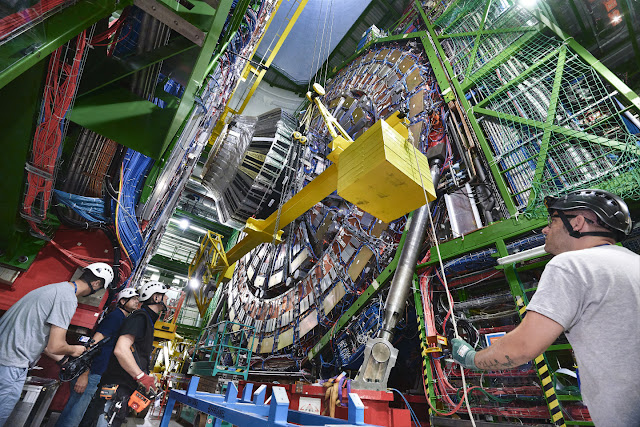CERN - European Organization for Nuclear Research logo.
18 September, 2019
The CMS muon system is being upgraded to help track muons with ever-higher precision
Image above: The GEMs being installed in CMS (Image: Maximilien Brice/CERN).
Muons – heavy, weakly interacting particles – zip past the inner layers of the Compact Muon Solenoid (CMS), after being produced in collisions by the Large Hadron Collider (LHC). They are observed using special detectors placed on the periphery of the cylindrical device, where they are the particles most likely to register a signal. Although CMS, as the name suggests, was designed with the ability to observe with high precision nearly every muon produced within it, it will become more challenging to do so in a few years’ time. The High-Luminosity LHC (HL-LHC) will begin operations in 2026, providing on average over five times more simultaneous proton–proton collisions than before. Various components of CMS, including the muon system, are being upgraded during the ongoing second long shutdown (LS2) of CERN’s accelerator complex, in order to cope with the HL-LHC’s higher data rates.
Muon detectors contain different mixtures of gases that get ionised when high-energy muons fly through them, providing information about where the muon was at a given instant. The CMS muon system has so far used three different types of detectors: Drift Tubes (DT), Cathode Strip Chambers (CSC) and Resistive Plate Chambers (RPC). Around a decade ago, at about the time that CMS began collecting LHC collision data, it was decided to build a completely new type of detector called Gas Electron Multipliers, or GEM, to improve the muon-detection abilities of CMS in the HL-LHC era. After extensive R&D, the first GEMs were assembled and tested at CERN’s Prévessin site in a dedicated fabrication facility. In July, two of 72 so-called “superchambers” of GEMs were transported carefully to Point 5 and installed within CMS. Each superchamber had a bottle of gas strapped on top of it on the trolley so the detector could keep “breathing” the inert air. The remaining 70 superchambers will be installed later in LS2.
“The GEMs are new technology for CMS and Run 3 of the LHC will give us the opportunity to evaluate their performance,” says Archana Sharma, who has led the CMS-GEM team since 2009. “Of course,” she continues, “it’s not only there to be tested. The first GEMs will work with the existing CSCs to provide valuable triggering information to select the most interesting collision events.” Two more GEM stations with 288 and 216 modules respectively will be definitively installed in the coming years, in time for the HL-LHC.
The muon-system team have been busy upgrading the electronics of the 180 CSCs located closest to the beam line to prepare for the HL-LHC. “We have already removed, refurbished and reinstalled 54 CSCs this year,” notes Anna Colaleo, CMS muon-system manager. “Work on replacing the electronics for another batch of CSCs is in progress and we plan on completing this endeavour by the summer of 2020.”
CMS CSC chamber's trip for new electronics
Video above: A timelapse showing the extraction of CSCs from the CMS endcap and their transport to the refurbishment area on the surface (Video: CMS/CERN).
CMS is also performing critical maintenance on the rest of the muon detectors during LS2. As expected, over the course of several years of operation, some components of these detectors have deteriorated slightly. The RPCs have been made more airtight to reduce gas leaks, while both DTs and RPCs have had some broken components replaced. In addition, neutron shielding is being added to the top of the DTs located in the central barrel to protect CMS from the neutron background caused by the particle beam interacting with the beam pipe.
With nearly a year and a half of LS2 left, the CMS experiment site at LHC Point 5 continues to be a hub of activity as the collaboration prepares for the LHC’s Run 3 and beyond.
More photos of the GEMs installation on CDS: https://cds.cern.ch/record/2684028
Note:
CERN, the European Organization for Nuclear Research, is one of the world’s largest and most respected centres for scientific research. Its business is fundamental physics, finding out what the Universe is made of and how it works. At CERN, the world’s largest and most complex scientific instruments are used to study the basic constituents of matter — the fundamental particles. By studying what happens when these particles collide, physicists learn about the laws of Nature.
The instruments used at CERN are particle accelerators and detectors. Accelerators boost beams of particles to high energies before they are made to collide with each other or with stationary targets. Detectors observe and record the results of these collisions.
Founded in 1954, the CERN Laboratory sits astride the Franco–Swiss border near Geneva. It was one of Europe’s first joint ventures and now has 23 Member States.
Related links:
Compact Muon Solenoid (CMS): https://home.cern/science/experiments/compact-muon-solenoid
Large Hadron Collider (LHC): https://home.cern/science/accelerators/large-hadron-collider
High-Luminosity LHC (HL-LHC): https://home.cern/science/accelerators/high-luminosity-lhc
Second long shutdown (LS2): https://home.cern/tags/long-shutdown-2
The GEMs are new technology for CMS: https://home.cern/news/news/experiments/cms-tightens-its-net-around-muons
For more information about European Organization for Nuclear Research (CERN), Visit: https://home.cern/
Image (mentioned), Video (mentioned), Text, Credits: CERN/Achintya Rao.
Greetings, Orbiter.ch


